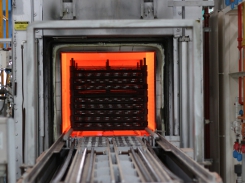- Corporate
- Chemical Products
- Chemical Controller
- Chemical for Paint Booth
- Coil Coating
- Degreasing and Cleaning chemical
- Heat&Cool exchanger (PLATECOIL)
- Hydrophilic
- Manganese Phosphate
- Nano-coating (Pallucid)
- Rolling Oil
- Rust Preventive Product
- Stearate Soap Lubricant/Dry-in-Place Lubricant (PULS)
- Trivalent Chromium/Non-Chromium
- Zinc Phosphate/Iron Phosphate
- Processing Services
- Laboratory Services
- Articles
- What's New
- Contact Us
- Privacy Policy
How Many Types of Hardness Tests Are There? Why Do They Matter?
06 October 2021
The hardness test is a simple way to determine the hardness of different types of materials. Different tests are often required for different materials, and there are many ways in which you can perform a hardness test. In this blog post, we will review some common methods and discuss why they matter.
What is the Hardness Test?

You may be asking yourself, what is hardness? Well, hardness in scientific definition is the ability of a material to resist an applied force. The hardnes
s of a material is typically measured using one or more of several methods.
Why Do We Care About Hardness Tests?
The hardness of a material is very closely related to other properties like wear resistance and toughness, so it makes sense why we care about all three types of tests: Rockwell tests are good at differentiating between materials with similar levels of carbide content; Brinell tests differentiate between high-carbon steels and low carbon stainless steel; and Vickers tests can be used across multiple fields including metallurgy, mining, geology, chemistry, physics, biology/medicine among many others.
Types of Hardness Test

To answer the question, how is hardness measured? Here are the three main types of hardness test methods. This include the three following methods;
- Rockwell Hardness Test
The Rockwell hardness test procedure involves pressing an object with known geometry into the surface of your sample at different loads until you get to a certain depth or threshold load. (the point where deformation occurs)
You then measure how much penetration has occurred and compare that value to measurements from other samples in order to determine their relative hardness. Because this test uses indentation rather than some sort of cut-away, it's not good at testing metals without carbide tips because small cracks may form on the sides, which could influence your results. - Brinell Hardness Test
If you want to answer the question of how to test hardness on items, the Brinell test is one of the main methods. Brinell hardness testing involves pressing a hardened steel ball into the surface of your sample at different loads until you get to a certain depth or threshold load. You then measure how much penetration has occurred and compare that value to measurements from other samples in order to determine their relative harnesses. - Vickers Hardness Test
The Vickers hardness test uses not one but two tests, both involving diamond pyramid-shaped objects called "indentors." As mentioned above, these are pressed into the surface of your sample at different loads until you get to a certain depth or threshold load.
The two types of indenters are the Vickers indenter and Knoop indenter. Since this test involves cutting away material, it's good for testing metals with hard carbide tips because there is less risk of small cracks forming on the sides, which can influence results.
Pros and Cons of the Three Hardness Test
All three methods have pros and cons depending on what type of material are used when conducting experiments on how to measure hardness: Rockwell tests should only be used when your samples don't contain any carbides; Brinell tests tend to give lower penetration depths than other methods, and Vickers tests require more time but produce higher accuracy measurements under smaller loads. As such, it's important to choose the test that is appropriate for your sample.
It's important that an appropriate method is chosen so that accurate measurement can be taken, as each method has its own pros and cons depending on what type of material you're trying to measure. Just because Brinell tests tend to give lower penetration depths than other methods doesn't mean they aren't useful - especially when testing metals without carbide tips.
Other Types of Hardness Tests
Now that you have learned about the most common types of hardness tests, and how they work. These tests are done to determine how hard an object is, and to do this; you must conduct quite a couple of tests. Here are other types of hardness tests that can be conducted to provide accurate outcomes.
- Knoop Hardness Test
This is similar to the Vickers test but uses a Knoop indenter instead of a pyramid-shaped diamond object. It's popular in metallography because it produces high accuracy measurements under very small loads, which can be useful for testing thin films or hard materials. - Shore Hardness Test
This is a test often performed on rubbers and plastics. It's similar to the Brinell test, but instead of using a hardened steel ball, you use an indenter with Shore hardness markings (similar to colors). Softer materials will give lower penetration depths compared to metal hardness testing because the material deforms more easily under higher loads. - Compression Tests
This involves squeezing your samples between two flat objects until they break apart or deform significantly enough, which shows their relative compression strength. Since this method requires little preparation time and gives relatively quick results, it can be useful for determining if different types of polymers are suitable candidates for certain applications such as adhesives or gaskets/seals. - Mohs Hardness Scale
The Mohs scale is a way of classifying minerals based on their hardness. It was developed in 1822 by German mineralogist Friedrich. This method is preferred to use when determining the hardness of any unknown mineral. For example, if you find an unidentified rock, then place a known piece with that number next to it and see which one scratches the other first. That will tell you roughly what type of material your sample is made up of.
Using a Hardness Measuring Instrument
In order to accurately take a Rockwell, Brinell, or Vickers hardness test, you'll need a high-quality instrument. There are many different types on the market today that range in price depending on how much accuracy you need, but if you're just getting started with hardness testing, then it may be prudent to start out small.
One of the most popular handheld devices is called a Rockwell Hardness Tester (also known as a Durometer) because they can measure all three scales plus provide good precision for everyday applications like determining if your knife blade needs sharpening or knowing when it is time to replace an aging file set.
No matter what type of test it is, environmental factors can result in discrepancies. Therefore, factors must be controlled. These include surface preparation, length of time of pressing, speed, temperature and humidity. That's why it's important to have an expert conducting the test.
Conclusion
There are many ways in which you can perform a hardness test for your sample depending on what material it is made of, how much indentation you need to make, and other factors.
Thai Parkerizing, as a leader in coating, surface treatment and heat treatment technology for a wide range of purposes, including customers in the automotive parts industry, continues to persist in research and development to create effective solutions for customer needs. Our wide range of products and services include surface and metallurgical analysis and various testings presented below.
Tag :









